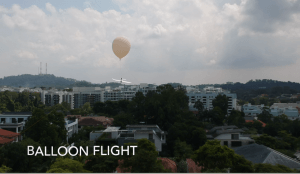What we achieve and did not
In conclusion, our group have managed to successfully proven the concept of deploying a glider drone from the balloon. We have also shown that it is possible for the glider to be grounded manually instead of autopilot.
However, one thing we did not achieve was to successfully test of the automated flight system after the balloon release. Using video footages we collected from the plane and on ground, we were about to narrow it down to 3 possible reasons:
(1) The response time of the autopilot system to ‘kick in’ was too long. This means when we flip the switch from manual to auto, there is a delay in the autopilot system kicking in and the plane plummets.
(2) The second reason is closely tied to the first. Because all our flight tests are done in Singapore and there are drone-height flying constraints, there simply was not enough height for the drone to pitch itself back up. I.e. even if the response time of the autopilot kicking in is slow, but there is enough height, the plane can stabilize itself and fly. In our video footage, we saw evidence of that, except that as there was not enough height for the plane to recover and it simply hits the ground.
(3) The calibration of the plane was not as optimal as we want it to be (due to earlier crashes) and the autopilot system did not work ideally.

Post MnT Reflection
CY2003/PS9888 Making & Tinkering has been a challenging but fulfilling module – one which entails messing with crazy ideas and attempting the unorthodox. Our group in particular took it to a whole new level, by diving into a aerospace/electrical engineering feat with nothing but a chemical engineer, a chemist, a biologist and two earth scientists. Without much prior knowledge on circuit building and drone constructing and piloting, we started off the term like kids in a sandbox, poking at all the unfamiliar technology around us. Over the special term, there were times when we felt demoralised, overwhelmed and defeated, but ultimately, we stuck to the cause that brought us together in the first place, and pushed through with hard work.
Drones, despite being a proliferated technology, have a rather fenced-off community in Singapore. Forums were littered with technical terms and jargon, which made it hard for us get started. To build a drone from scratch, we scoured through numerous online shops to find the machine parts with the best price and credibility. Even when we did find the a good choice, certain listings would have typos in their names, which made us hesitate a little before clicking on the “Buy” button each time. Then came the long period of uncertainty – the wait we had to endure before our parts arrived (or not). Most advice given to us then involved “read up on ____” or “just google it”, but we all knew that looking at online diagrams were just scratching the surface of the art of drone building.
When our equipment started coming in piece by piece, we were greeted by gear which had wrong connector heads and tails. Thus came our in-house soldering bootcamp, where we spent hours and hours welding tin alloys and fixing heat shrinks on our hardware. On hindsight those hours were oddly therapeutic, as we played songs for the our group to sing along to as we worked our days away. That experience really got us comfortable with one another 🙂
The numerous drone flying tests we conducted were the true test to our friendship, as teamwork, patience, and trust all came into play. By Murphy’s Law, every plan we had could definitely go wrong. Whether it was the case of bad weather, balloon mishap or drone hard landings, those days were the days of the wildest highs and lows, and as such, the most memorable. We definitely wouldn’t forget the shock of our first balloon bursting, the pain as the drone plummeted from the air and muscled into the dirt, and the elation when our system delivered its first success.
All in all, MnT was a roller coaster ride. The fear before hopping on the project, the excitement as the project took off, and nervousness and worry as our workloads and complications peaked, and the adrenaline and cries as we zoomed down onto the field tests. Now that we are about to get off this ride of our lives, we are all certain that the experience and memories would linger on for years to come.
To end it off, we would like to thanks Dr Ho, Kanesh, Tony, Guo Yao and all the other lab staff for their endless patience and all the advice provided. For without which, this project would not have been made possible.

